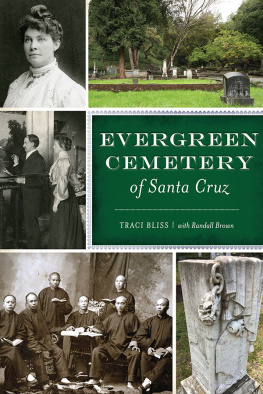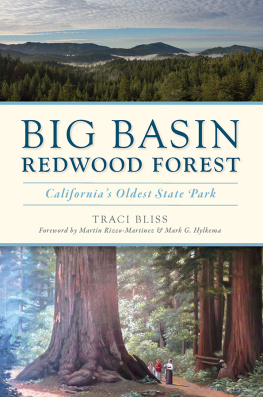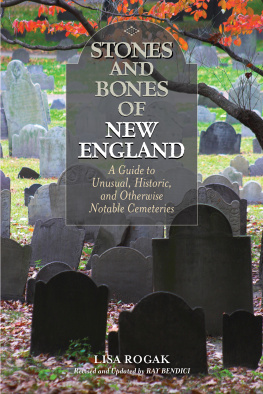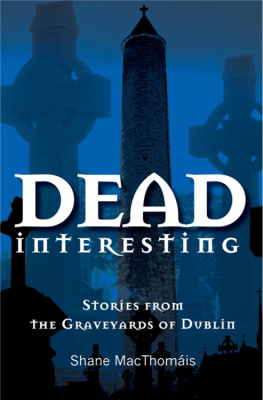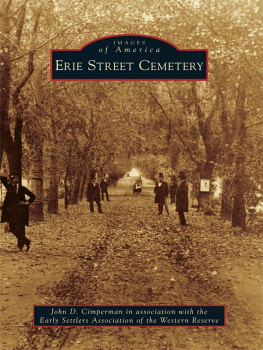


Published by The History Press
Charleston, SC
www.historypress.com
Copyright 2020 by Traci Bliss
All rights reserved
Front cover, clockwise from top left: Belle Dormer; Scott family plot, for whom Scotts Valley was named. Photo by Heather Grimes; Memorial for Fleck and Denison families. Photo by Gary Neier; Men of the Congregational Chinese Mission; Frank and Lillian Heath.
First published 2020
e-book edition 2020
ISBN 978.1.43967.154.2
Library of Congress Control Number: 2020930481
print edition ISBN 978.1.46714.386.8
Notice: The information in this book is true and complete to the best of our knowledge. It is offered without guarantee on the part of the authors or The History Press. The authors and The History Press disclaim all liability in connection with the use of this book.
All rights reserved. No part of this book may be reproduced or transmitted in any form whatsoever without prior written permission from the publisher except in the case of brief quotations embodied in critical articles and reviews.
CONTENTS
To Judith Steen, whose expertise and steadfast commitment to historic preservation and womens history is an enduring contribution to Santa Cruz County.
ACKNOWLEDGEMENTS
Ive been fortunate to have two indispensable resources for exploring Evergreens past: preservationist Judith Steen as a mentor and the Evergreen Cemetery Preservation Plan as a big picture guide. Also essential has been the productivity of several individuals whose work, spanning decades, provided a rich foundation for the stories I tell: Dana Bagshaw, Geoffrey Dunn, Ross Gibson, Rick Hyman, Sue Kerr, Margaret Koch, Sandy Lydon, Joan Martin, Joe Michalak, Robert Nelson, Ernest Otto, George Ow Jr., Norman Poitevin, Marion Pokriots, Phil Reader, Martin Rizzo, Leon Rowland, Stan Stevens, Carolyn Swift and Paul Tutwiler.
Descendants of men and women who were buried at Evergreen early onNancy Kilfoyl Campeau, Jim Lorenzana, the Newcomb and Schupbach families and Casey Tefertillershared detailed family stories and photo archives. Their generosity and great help enabled me to create multigenerational sagas, as inspiring as they are diverse.
The chapters titled Evergreens Renaissance and Families Then and Now offer a window into several years of consistent and extensive restoration efforts by Evergreen Committee volunteers. I am indebted to Nancy Campeau, Kate Clark, Bob Dahlgren, Sangye Hawke, Anne Hayden, Frank Hayden, Judy Jones, Cynthia Mathews, Mary Jo May, Gary Neier, Dave Newcomb, Sibley Simon, Winston Spedding and Mary Wood. In addition, Ms. Mathews and Ms. Jones lent me their meticulous document collections. The Santa Cruz Museum of Art and Historys (MAH) curator of history, Marla Novo, serving as the Evergreen Committee chair, made available many unique photographs from MAHs exceptional archive. I want to give much-deserved thanks to the MAH Publications Committee for the many Santa Cruz County History Journals, from which I drew essential context for the 1800s. For rare documents and key source materials, generally unavailable elsewhere, the reference collection and newspaper indexing project of the Santa Cruz County Genealogy Society have been invaluable.
I am honored to have received a grant from the Santa Cruz County History Forum; contributions from individual Forum members Nancy Campeau, Burt Rees and Mary Wood; and the 2018 Dolkas/Mertz Awardall of which helped to support dedicated consultants. My heartfelt thanks to editor Martha Mee Dunn, genealogist Marion Pokriots, historian Randall Brown and photo production manager Gary Neier and his wife, Tara. Special appreciation goes to Laurie Krill, Arcadia/History Press acquisitions editor, for her confidence in an untested idea and Elizabeth Humphrey, my niece, for her wisdom and encouragement. My watchful feline companions, Bella and Paws, supplied much-needed levity at critical junctures.
Prologue
GATEWAY TO THE PAST
James Imusthe first person buried at what would ultimately become Evergreen Cemeterydied at age nineteen in 1853. My maternal grandmother, Belle, told me a bit of the story. To protect the memories of James and his uncle, Captain Charles Imus, interred in 1856, our Imus ancestors donated their land for a cemetery open to all. As an inquisitive ten-year-old, I wanted to know more, but my mother dismissed any questions, adamant that our connection was too distant to matter and the graveyard too insignificant to visit. We took her admonition to heart: it would be fifty years before I ever set foot in Evergreen, and my brother on the East Coast never has.
After my mothers passing, my indifference to Evergreen took a radical turn when I discovered the name on Belles birth certificate didnt match the name shed always used. I felt compelled to investigate those too distant to matter relatives. Unearthing the well-hidden family secret sent me on what genealogist Marion Pokriotsmy sixth-grade teachercalled a sacred journey.
My grandmother, an only child, never once mentioned her father. A bigamist, he was apparently expunged from the family record soon after his sudden desertion of six-month-old Belle and her mother to marry another woman. Learning this from poring over Santa Cruz county records and documents at the Family Research Library in Salt Lake City, I began piecing together my unknown relationship to Evergreen. Belle always remarked on the goodness of Judge Henry Rice and his wife, Lucy Imus Rice, my great-great-great-grandparents, who helped build Santa Cruz in the early 1850s. But the anecdotes never meant much to me until, bolstered with new information, I explored the Rice family plot at Evergreen with its beckoning obelisk. What had Belle meant by the the Rices goodness? Tracking down third cousins Id never met, they explained that the judge and Lucy sheltered their granddaughterBelles motherfrom the intense shame she endured as an abandoned woman with an infant during the Victorian era.
Once I started down the path of exploring the burial grounds pastto better understand my ownI couldnt stop. Delving into the uniqueness of the men and women who coalesced to create a city and its surrounding towns became irresistible. From the moment of its founding, Evergreen evolved as an epic story of commitment: of parents to children preceding them; of Masons to their brethren; of soldiers to their comrades; of Chinese to their ancestors; and of the thousands of volunteers who have helped maintain the cemetery for over a century to honor those who went before.
Some individuals portrayed in these pages have been the stars of Evergreen history tours for decades. Here we tell their stories from a fresh perspective while sharing the enduring contributions of many others, not as biographies but rather as interlaced lives that helped mold the values of a very young and evolving town. If well-known pioneers do not appear, it is not because they were less important. Rather, we selected from a wide group of individuals, some better known and some lesser known, reflecting the diverse aspirations, occupations, vocations, ethnicities and cultures that intertwined to create Santa Cruz. Nearly two thousand additional residents are buried at Evergreen; I hope this modest beginning inspires the telling of their stories as well.
Next page
